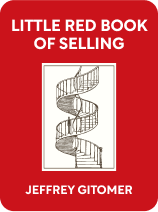

This article is an excerpt from the Shortform book guide to "Little Red Book of Selling" by Jeffrey Gitomer. Shortform has the world's best summaries and analyses of books you should be reading.
Like this article? Sign up for a free trial here .
Are you having trouble closing sales? What are the most effective closing techniques?
Knowing how to close a sale is a make-or-break skill in the sales profession. In his book Little Red of Selling, sales trainer Jeffrey Gitomer addresses three techniques that will help you clinch the deal: 1) help the buyer convince herself to buy, 2) eliminate the buyer’s risk, and 3) use customer testimonials.
We’ll discuss these three sales techniques below.
Jeffrey Gitomer: How to Close a Sale
Closing a sale is not something that comes at the end of your sales pitch. It happens all throughout the sales process. Here are three techniques on how to close a sale:
1) Help the Buyer Convince Herself to Buy
The 11th selling principle—helping the buyer convince herself to buy—requires a key sales skill: asking the right questions.
Most salespeople ask the wrong questions and therefore don’t get the answer they want (a “yes” to the sale). Usually, they’re questions aimed at getting the buyer to switch from a current supplier to your company. They often fail because they’re price-driven. For example:
- Who’s your current supplier?
- Are you satisfied with your service?
- How much are you currently paying for delivery? If I could save you some money, would you switch…?
- What would it take for me to win your business?
In contrast, the right questions help the buyer think about your product or service in terms of how it solves her problems or achieves her goals. They’re specific questions that uncover her frustrations, concerns, and needs so you can show how your product will make her life easier—and she’ll conclude that she needs it. When the customer thinks in terms of why she needs the product, she’s thinking on your terms as the seller; you’ve created a buying atmosphere.
Here’s an example of a wrong and a right question, for selling a messaging system:
- Don’t ask: “What kind of call-forwarding system do you have?” or “Do you use pagers?”
- Instead, ask: “If your most important customer called right now, how would you get the message? How confident are you that you’d get it immediately?”
To ensure you’re always prepared to ask the right questions, develop a list of questions that you can adapt to uncover each customer’s needs, concerns, and frustrations. Some useful introductory phrases include:
- What do you look for in choosing a…?
- What’s been your experience with…?
- What would you change…?
- What’s your biggest hurdle to…?
- What frustrates you the most about…?
- How do your customers react when…?
You’ll differentiate yourself by getting your prospect to think in new ways. A sign of success is when the customer remarks that no one ever asked her that question before—and her answer convinces her to buy.
2) Eliminate the Buyer’s Risk
The biggest hurdle to a sale is the risk the customer believes he’d take in buying your product. If you eliminate the risk, the customer will buy.
A risk is anything that makes a customer hesitate to buy. It can be difficult to identify the risk standing in the way because what seems risky to the customer may seem trivial to the salesperson. Common concerns or risks to the customer are:
- Am I making a mistake and not getting my money’s worth?
- Will I look bad or get into trouble for making a poor decision?
- Am I taking too big of a financial risk—can I really afford it?
- Do I really need it? I might regret buying it.
- Can I get something cheaper or better elsewhere?
- Is it what I really want? It’s different from the way I pictured it.
- Will it work? What if it doesn’t? Will it soon become obsolete?
- Will I be able to get service for it?
These concerns indicate the customer lacks confidence in the product, company, salesperson, or their own judgment. When the customer says, “I’ll think about it and get back to you” or “Let me discuss it with so-and-so,” the sale is off unless you identify the risk and eliminate it.
Uncover and Counter Customer Concerns About Risk
Here are some ways to counter customer concerns:
1) Prepare for risk obstacles by identifying the customer’s potential risks and preparing responses or preemptive statements that eliminate the risks. Practice the responses until you master them.
2) Determine the customer’s risk tolerance—ask about previous purchases they’ve made and how those turned out. Ask what their concerns were prior to those purchases and how they overcame them. Then address those risks.
3) Suggest a few concerns that might be bothering the customer and answer them—for example:
- “If you’re concerned that it might not work for you, remember that you can always return it.”
- “We sell many of these to similar companies, but if your company ends up not liking it, we’ll provide a full refund.”
- “If you’re wondering if you can get a better price, you should know that we’re so confident in our price, we’ll match any lower price quote.”
4) Ask the customer to compare risks and rewards. This process takes practice, but it’s highly effective:
- When the customer hesitates to commit, ask him to list the risks of buying. Write them down, and prompt him to add to the list until he runs out of concerns.
- Next, ask the customer to list the rewards. Write them down, elaborating on each as much as possible.
- One at a time, eliminate each risk with comments such as: “Did you know about our warranty…”, “What if we could…,” or “I think we can include…”
- Ask, “Is there any other reason not to proceed?” Reiterate the rewards and close.
As an alternative risk-reward comparison, just ask the customer, “What’s the risk versus the reward?” and “What’s the need versus the value?” Then help her see how the reward outweighs the concern, and the value more than meets the need.
3) Let Your Customers Speak for You
The final selling principle—use customer testimonials to help you sell—is powerful but underused. Customer testimonials are powerful for two reasons:
1) They’re believable. When you talk about your offerings, it’s bragging, but when customers give testimonials, it’s proof of your product’s value.
2) Done correctly, testimonials prompt people to buy. To prompt action, testimonials must make specific, not general statements, for example:
- Ineffective (general): “The people at company X are wonderful. We’ve been doing business with them for years.”
- Effective (specific): “I improved my skills 100%” or “Since I had this training, my employees actually listen to me.”
Testimonials can be written or on video. An effective written testimonial:
- Highlights a benefit of your product or service: “I doubled my profits.”
- Overcomes an objection: “I thought the price was too high, until I tried the product and realized the value.”
- Makes a call to action: “I used to use another brand but wasn’t satisfied until I switched … and you should too.”
- Provides a happy ending: “My family loves it.”
Video testimonials, when shown at the end of a sales call, are an effective way to dispel doubts, reduce risk, and confirm the value of your product. However, while the video reinforces the sales message, the salesperson still must close the deal.
To produce an effective video testimonial:
- Before you start, watch similar videos to see what works and get an idea of what you want.
- Spend the money for high-quality production; a poor video will reflect poorly on your product or service.
- Limit the length to five to eight minutes; if the video is too long, viewers will tune out.
- Write a script.
- Make it look and sound real, not contrived, to ensure potential customers actually trust the testimonial.
- Let the customer do the majority of the talking, since the customer’s bragging about your product is more convincing than your assertions.
To get people to provide testimonials, simply ask them. It’s even OK to tell the customer what to say, as long as it’s the truth.

———End of Preview———
Like what you just read? Read the rest of the world's best book summary and analysis of Jeffrey Gitomer's "Little Red Book of Selling" at Shortform .
Here's what you'll find in our full Little Red Book of Selling summary :
- Jeffrey Gitomer’s 13 principles of selling
- How to eliminate hurdles and win more sales
- The reasons why people buy even though they don't like being sold to






